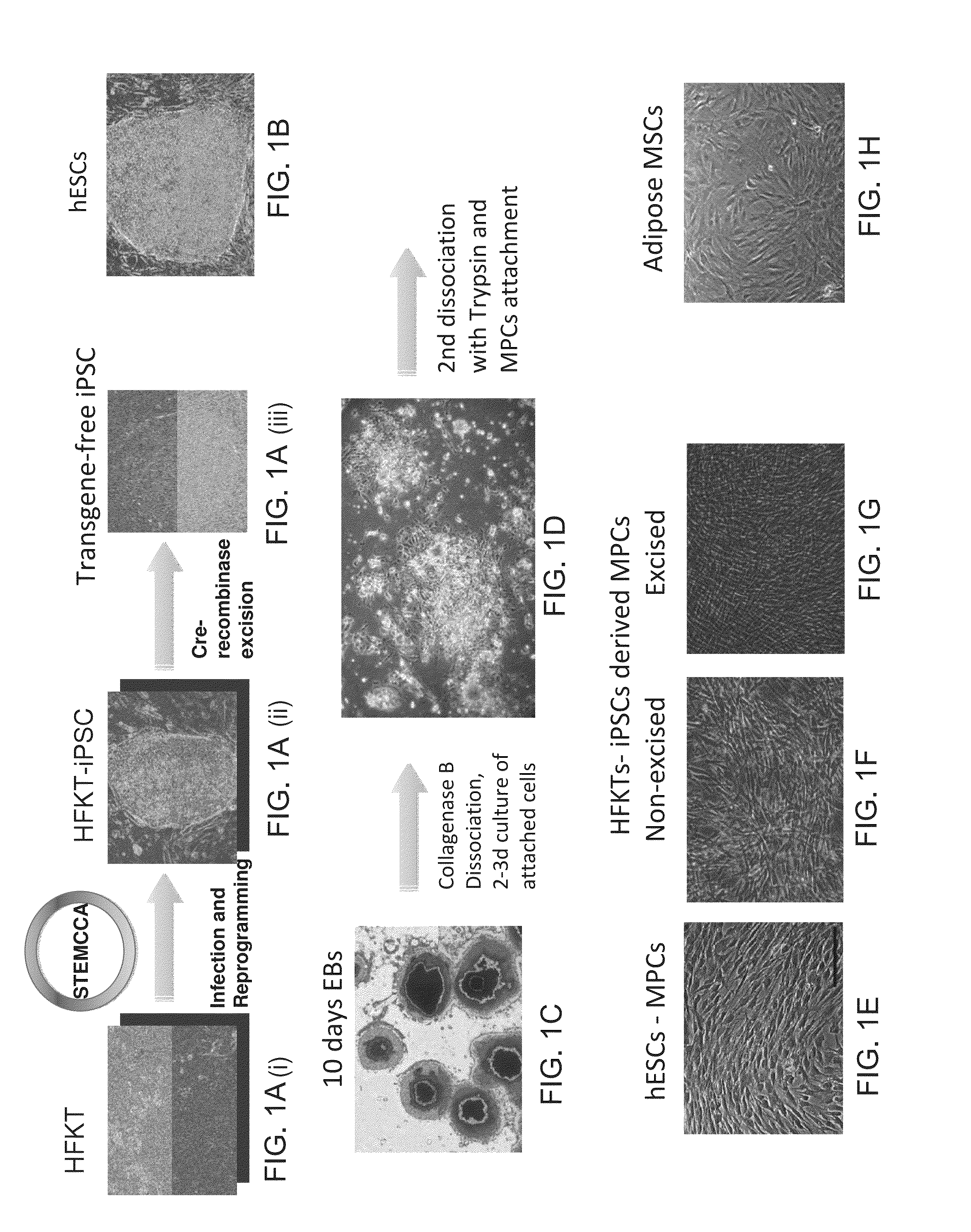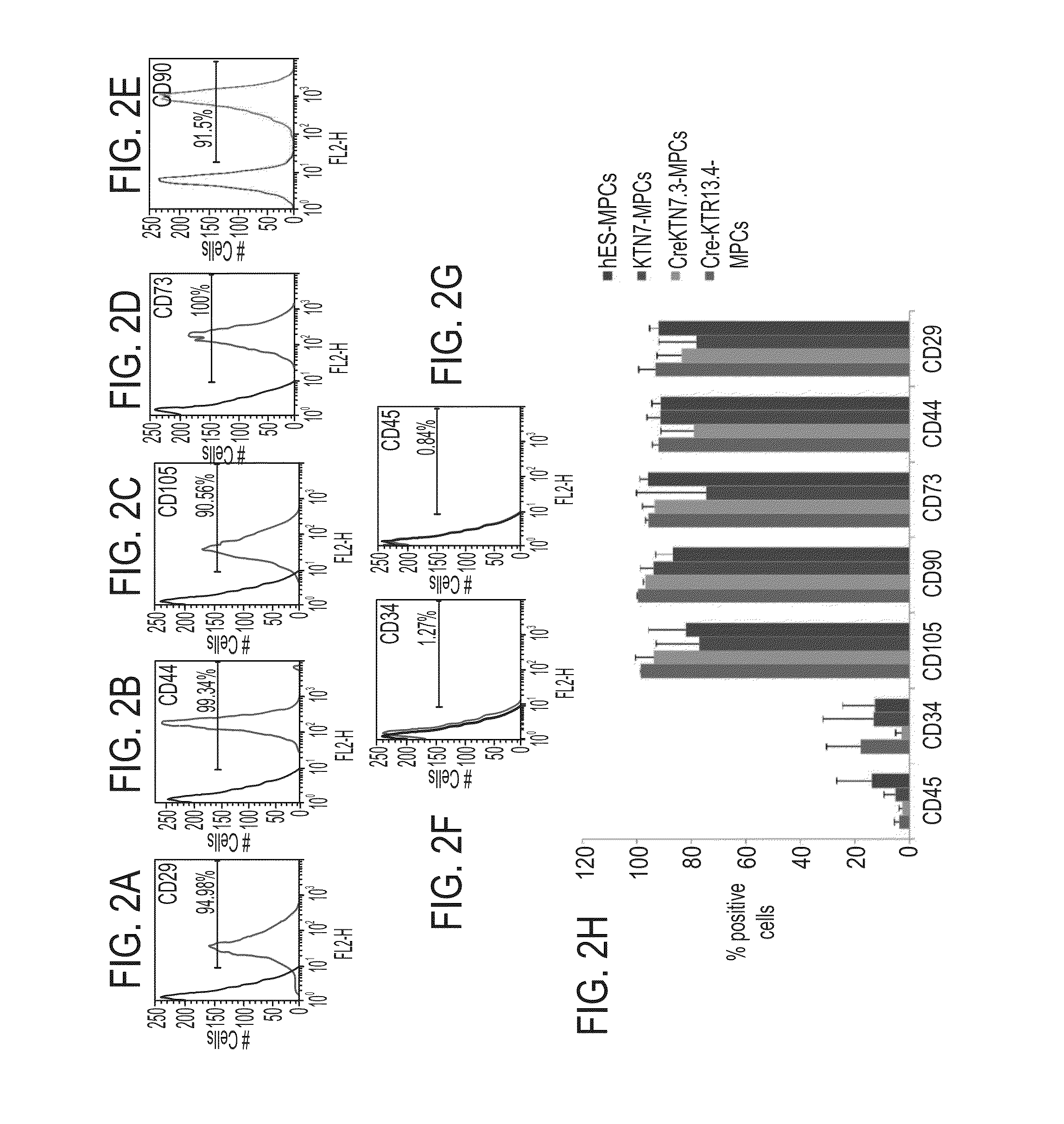Isolated mesenchymal progenitor cells and extracellular matrix produced thereby
a technology which is applied in the field of isolated mesenchymal progenitor cells and extracellular matrix produced thereby, can solve the problems of reduced protective factors, limited proliferation capacity of adult mscs, and loss of differentiation potential, so as to reduce the differentiation into an adipogenic lineage of mesenchymal progenitor cells
- Summary
- Abstract
- Description
- Claims
- Application Information
AI Technical Summary
Benefits of technology
Problems solved by technology
Method used
Image
Examples
example 1
Derivation of Mesenchymal Progenitor Cells (MSCs) from Pluripotent Stem Cells
[0323]The present inventors have uncovered a novel method of generating mesenchymal progenitor cells from pluripotent stem cells (hESCs or hiPSCs). The major method steps include:
[0324](1) enzymatic dissociation (e.g., using collagenase B) of EBs (e.g., 10-days old) into small aggregates;
[0325](2) culturing of the cell aggregates as adherent cells to a tissue culture plate (devoid of gelatin or any adhesive material) for 2-3 days with BHK medium which triggers mesenchymal differentiation of the cells;
[0326](3) harvesting the cells and further dissociating them into a single cell suspension using. Trypsin. The cells are allowed again to attach the tissue culture plate surface and cultured with BHK medium.
[0327]This protocol is simple and reproducible and can be used for generating mesenchymal progenitor cells which can produce high amounts of ECM for regenerative medicine applications.
[0328]Experimental Resu...
example 2
The Mesenchymal Progenitor Cells Derived According to the Method of Some Embodiments of the Invention Express Typical Mesenchymal Cell Surface Markers
[0336]Experimental Results
[0337]Characterization of MPCs by FACS Analysis—
[0338]To characterize the newly derived MPCs the expression of typical mesenchymal cell surface markers was tested using Flow cytometry analyses and compared to that of mesenchymal stem cells derived from an adipose tissue, which is used as a gold-standard. The FACS analysis revealed that adipose-derived MSCs are positive for expression of CD29 (FIG. 2A, 94.98%), CD44 (FIG. 2B, 99.8%), CD105 (FIG. 2C, 98.56%), CD73 (FIG. 2D, 100%) and CD90 (FIG. 2E, 91.5%) and were almost completely negative for expression of CD34 (FIG. 2F, 1.27%) and CD45 (FIG. 2G, 0.84%). FIG. 2H shows that MPCs derived from excised HFKT-iPSCs clones (Cre-KTN7.3 or Cre-KTR13.4) were 90-100% positive for all tested MSCs markers (CD29, CD44, CD105, CD73 and CD90). MPCs derived from non-excised HF...
example 3
The Mesenchymal Progenitor Cells Derived According to the Method of Some Embodiments of the Invention Exhibit a Significantly Reduced Ability to Differentiate into an Adipogenic Lineage
[0339]Experimental Results
[0340]The MPCs of Some Embodiments of the Invention are Capable of Forming a mineralized matrix—
[0341]The mesenchymal progenitor cells isolated according to the method of some embodiments of the invention were cultured in an osteogenic medium for 28-30 days and at the end of the culturing period the cells were stain with Alizarin Red (which tests presence of a mineralized matrix). As shown by Alizarin Red (AZR) staining calcium deposits and bone nodule formation was visible in both hESC-derived MPCs and iPSc-derived MPCs (FIGS. 3A-D). Thus, all the lines of mesenchymal progenitor cells were capable of forming mineralization in the culture at day 30 of culturing in an osteogenic medium.
[0342]The MPCs of Some Embodiments of the Invention Exhibit Low or No Differentiation Capaci...
PUM
| Property | Measurement | Unit |
|---|---|---|
| Fraction | aaaaa | aaaaa |
| Fraction | aaaaa | aaaaa |
| Fraction | aaaaa | aaaaa |
Abstract
Description
Claims
Application Information
 Login to View More
Login to View More - R&D
- Intellectual Property
- Life Sciences
- Materials
- Tech Scout
- Unparalleled Data Quality
- Higher Quality Content
- 60% Fewer Hallucinations
Browse by: Latest US Patents, China's latest patents, Technical Efficacy Thesaurus, Application Domain, Technology Topic, Popular Technical Reports.
© 2025 PatSnap. All rights reserved.Legal|Privacy policy|Modern Slavery Act Transparency Statement|Sitemap|About US| Contact US: help@patsnap.com



